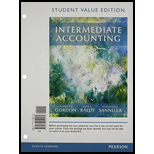
Concept explainers
Basis for Conclusions Case 2: The Lower of Cost or Market - U.S. GAAP, IFRS
Reprinted from the Ernst & Young Academic Resource Center with permission of the Ernst & Young Foundation. Copyright 2014, All rights reserved.
Scene 1
Both IFRS and U.S. GAAP require that firms report Inventory at the lower of cost or market. What is the basic principle/characteristic behind this standard that results in this “lower” reporting approach (asset write-down)?
Scene 2
Read the objectives for IFRS (IASC, International Accounting Standard 2. paragraph 1) and U.S. GAAP (FASB ASC 330-10-10-1).
Based upon what is stated in these objectives, which set of standards is more concerned with the
Scene 3
Do you think that the reversal of a write-down of inventory does a better job of accurately reflecting the information related to inventory on the balance sheet or on the income statement?
Is the fact that U.S. GAAP disallows the reversal and IFRS allows the reversal consistent with the objectives?
Scene 4
Currently, IFRS is more likely than U.S. GAAP to report assets at fair value (e g . property, plant and equipment can be revalued under IFRS but not U.S. GAAP)
Is the IFRS requirement that prior inventory write-downs be reversed a different way of saying that inventory should be reported at market value under IFRS?
Scene 5
While neither IASC, International Accounting Standard 2 nor FASB ASC 330 provides the reasoning for why the reversal of inventory write-downs is allowed or not allowed, the issues surrounding the reversal of write-downs for long-lived assets should be quite similar. Read the basis of conclusions under U.S. GAAP (FASB, Statement of Financial Accounting Standards No. 144, paragraph B53) and under IFRS (IASC, International Accounting Standard 36. paragraphs BCZ 182 through BCZ 186) that provide a discussion of the reasons the Boards made the decisions that they did.
What are the reasons that one might oppose reversals? What are the reasons that one might support reversals?
Scene 6
Do you believe that companies should be allowed/required to reverse prior inventory write-downs if the market value of the inventory increases in periods subsequent to the initial write-down?
Want to see the full answer?
Check out a sample textbook solution
Chapter 10 Solutions
Intermediate Accounting - Myaccountinglab - Pearson Etext Access Card Student Value Edition
- Which document is used to track the movement of inventory into and out of the warehouse?A. InvoiceB. Purchase OrderC. Goods Received NoteD. Inventory Ledgerarrow_forwardNo chatgpt Which document is used to track the movement of inventory into and out of the warehouse?A. InvoiceB. Purchase OrderC. Goods Received NoteD. Inventory Ledgerarrow_forwardWhich document is used to track the movement of inventory into and out of the warehouse?A. InvoiceB. Purchase OrderC. Goods Received NoteD. Inventory Ledgerhelparrow_forward
- Need help If total liabilities are $25,000 and owner’s equity is $15,000, total assets equal:A. $10,000B. $25,000C. $40,000D. $15,000arrow_forwardSolve it If total liabilities are $25,000 and owner’s equity is $15,000, total assets equal:A. $10,000B. $25,000C. $40,000D. $15,000arrow_forwardIf total liabilities are $25,000 and owner’s equity is $15,000, total assets equal:A. $10,000B. $25,000C. $40,000D. $15,000 help.arrow_forward
- When a company pays rent in advance, it should record:A. Rent ExpenseB. Unearned Rent RevenueC. Prepaid Rent (Asset)D. Accrued Rentarrow_forwardIf total liabilities are $25,000 and owner’s equity is $15,000, total assets equal:A. $10,000B. $25,000C. $40,000D. $15,000arrow_forwardDon't use chatgpt When a company pays rent in advance, it should record:A. Rent ExpenseB. Unearned Rent RevenueC. Prepaid Rent (Asset)D. Accrued Rentarrow_forward
- No Chatgpt please 5. What is the normal balance of the Dividends account?A. DebitB. CreditC. Zero balanceD. Depends on the type of dividendarrow_forwardDon't use ai tool 4. A purchase of equipment for cash will:A. Increase assetsB. Decrease total assetsC. Have no effect on assetsD. Increase liabilitiesarrow_forwardNo AI tool 5. What is the normal balance of the Dividends account?A. DebitB. CreditC. Zero balanceD. Depends on the type of dividendarrow_forward
 Auditing: A Risk Based-Approach (MindTap Course L...AccountingISBN:9781337619455Author:Karla M Johnstone, Audrey A. Gramling, Larry E. RittenbergPublisher:Cengage Learning
Auditing: A Risk Based-Approach (MindTap Course L...AccountingISBN:9781337619455Author:Karla M Johnstone, Audrey A. Gramling, Larry E. RittenbergPublisher:Cengage Learning
